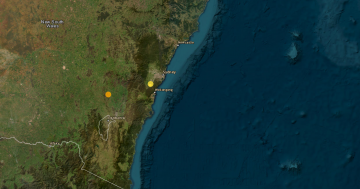
Dalton residents Bridget Jolley and Mike Stone near St Matthews Anglican Church. The church’s cross was knocked crooked by the magnitude 4.0 Oolong earthquake in 1984. Photo: Supplied.
As slight as they were, four small earthquakes over the past week near Dalton shook up newly arrived residents, making the locals chuckle at their nervousness.
“They’re all running around with crash helmets on, and we’re laughing,” Mike Stone said. “Not literally, but they are saying, ‘Oh, that was a big one’,” he said. Having felt them over so many years in the village north of Gunning and Canberra, he barely notices them.
Geoscience Australia recorded a 2.5 magnitude quake on 17 March, a magnitude 2 quake on 19 March and again on 20 March, and a magnitude 1.9 quake on 21 March. All were centred on Oolong, five kilometres west of Gunning and five kilometres south of Dalton.
Geoscience Australia senior duty seismologist Hugh Glanville said the earthquakes were so slight and recorded at so few stations inherent errors were possible in their location and depth calculations, which ranged between two and five kilometres near the top of the Earth’s crust.
“The area is quite well known for seismic activity; it has had much larger earthquakes, magnitude 5.6 to 5.5 range in 1934, 1886 and 1949 that have previously caused damage in Dalton and the Gunning region,” he said.
“There is a reasonably active fault line in the area and lots of these small earthquakes are accommodating and then releasing stress along those faults,” he said.
Earthquakes have previously been recorded over Lake George, Bowning and near Rye Park. “We are averaging seven earthquakes a year within 50 kilometres of these (recent) ones,” he said. “ It is quite an active area of Australia for these small earthquakes.”
Four people submitted ‘felt reports’ on the Geoscience website which Mr Glanville said would be useful in determining the strength of shaking and how far that shaking was travelling through the Earth’s surface. “We can then use that to refine the attenuation relationships, so that’s how the waves become smaller as they get further away,” he said.
Bridget Jolley has lived in Dalton for 27 years and in the region almost 36 years and recalls bigger earthquakes. “We were living out of town when I experienced my first one. That was quite alarming, because you actually heard that one coming – it felt like someone had picked up the house we were living in and then dropped it. That could be 32 years ago.”
Bridget and Mike said the bigger earthquakes could be heard coming and rumbling as they came closer, culminating in a loud bang before rumbling off into the distance.
This week Mr Stone thought someone had banged on the side of his house when one of the earthquakes erupted. “I had a big concrete slab poured on Saturday and it was a little dried. I was worried about that because it was still green,” he said. “There is no damage, no cracks so that gives an indication of how small (the tremors) were,” he said.
“We are renowned for having this fault line, it is part of our life. I think the worst damage was to the steeple above the Church of England, it didn’t fall but was left at an angle.”
Many years ago an earthquake was so severe Mike’s mother and father bolted from the house. Once outside his mother realised their children were still inside. Mike had slept blissfully through the whole episode.






